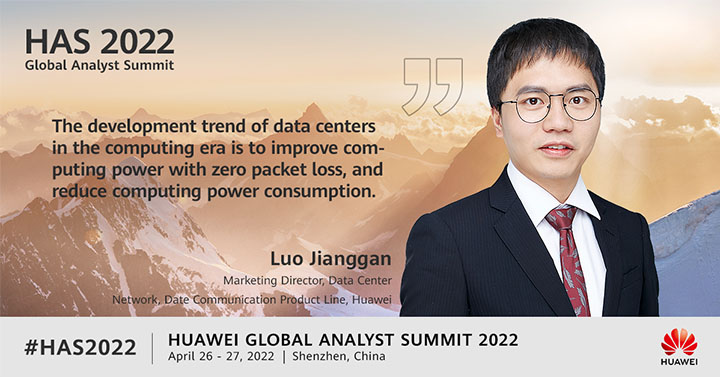Produits, solutions et services pour les entreprises
[Shenzhen, China, April 26, 2022] At the Huawei Global Analyst Summit (HAS) 2022, Huawei proposed the "Green and Low Carbon" concept for its Huawei CloudFabric 3.0 Hyper-Converged Data Center Network (DCN) Solution, with the aim of using lossless networks to improve computing efficiency and reduce computing footprint. By doing so, Huawei hopes to embrace the green computing era together with the industry.
As the digital economy enters the computing power era and global computing power initiatives such as China's "East-to-West Computing Resource Transfer" project get into full swing, the construction scale of data centers experiences explosive growth. In addition, as computing power and bandwidth increase, the energy consumption of data centers rises exponentially.
According to the latest statistics from the China Academy of Information and Communications Technology (CAICT), by the end of 2021, China's data centers had a combined total of more than 5 million standard racks. The Open Data Center Committee (ODCC), one of China's top non-profit organizations dedicated to data center research, found that China's data centers consumed 9.39 billion kWh of energy and emitted 64.64 million tons of carbon in 2020. This puts great strain on the carbon peaking and carbon neutrality goals.
At this year's HAS, Guo Liang, Deputy Chief Engineer of CAICT's Cloud Computing and Big Data Research Institute, delivered a keynote speech titled "Insight into Status Quo and Development Trend of the Computing Power Industry". Mr. Guo started by summarizing the opportunities and challenges brought by the "East-to-West Computing Resource Transfer" project, before delving deeper into the significant changes brought by data centers to the industry landscape, computing power structure, technological innovations, green and low carbon, and computing power enablement. The ODCC Data Center Computing Power White Paper (2020) spearheaded by CAICT pointed out that: Under the same server scale, improving network capabilities can significantly improve a data center's computing power per unit of energy consumption.

Quote of Guo Liang, Deputy Chief Engineer of CAICT's Cloud Computing and Big Data Research Institute
Leveraging lossless Ethernet networks, Huawei's CloudFabric 3.0 Hyper-Converged DCN Solution enhances network capabilities to maximize computing efficiency while minimizing the energy consumption per unit of computing power, thereby enabling green data center networks with optimal computing power.
• Lossless Ethernet, unleashing infinite computing power: Drawing on the iLossless 2.0 algorithm, Huawei's CloudFabric 3.0 Hyper-Converged DCN Solution implements the industry's first Ethernet with zero packet loss. In this way, it builds a large-scale, low-latency, and high-throughput computing power network, unleashing 100% of the computing power. For example, in the high-performance computing (HPC) scenario, the lossless Ethernet delivers 17% higher computing efficiency than the InfiniBand network, shortening the overall computing time.
• Energy saving and lowest power consumption per unit of computing power: CloudEngine data center switches use more than 10 cutting-edge heat dissipation and power supply technologies, such as SuperCooling and SuperPower, delivering 54% lower per-bit power consumption than the industry average and 47% lower power consumption per unit of computing power than the traditional Ethernet.
• Green and low-carbon manufacturing: Based on the principle of "no use, less use, and reuse", Huawei CloudEngine data center switches achieve sustainable low-carbon manufacturing. For example, to practice the "green and manufacturable" design, Huawei innovatively combined the independent packaging of optical modules into 6-in-1 integrated packaging, reducing the unpacking time by 85% and saving 18 tons of packaging materials.
In a hydrodynamics application test, the traditional network takes 375 seconds, while the lossless Ethernet completes the same task in just 198 seconds. This allows the lossless Ethernet to consume 47% less energy per unit of computing power than the traditional network.

Luo Jianggan, Marketing Director of Huawei's Data Center Network Domain
"Huawei's CloudFabric 3.0 Hyper-Converged DCN Solution has been widely applied in top-ranked AI computing centers, such as those in Wuhan and Xi'an. This field-proven solution delivers significant performance advantages in all-flash, distributed storage, HPC, and AI computing scenarios," said Luo Jianggan, Marketing Director of Huawei's Data Center Network Domain. "The lossless network powered by our solution improves computing power while reducing energy consumption, fully aligning with the trends of data centers in the computing power era. Huawei's CloudFabric 3.0 Hyper-Converged DCN Solution will continue to innovate and go deeper into digital to enable green development across industries and create a green future together with all stakeholders."